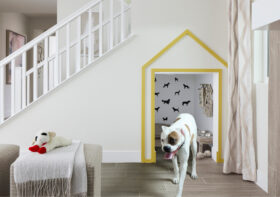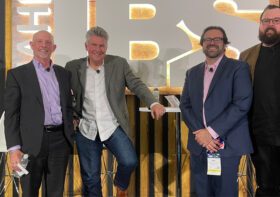Spotlight on Staff | Bob Wilhelm, Senior Principal
1) When did you realize that you wanted to be an architect?
When I was in the 3rd or 4th grade, I realized my love for drawing floor plans. Whenever I had paper in front of me, I would draw. On cross-country vacations, I spent hours in the car staring at buildings along the highways and redrew them from memory at night—especially gas stations; I thought they were very cool.
Because we traveled with a trailer—the idea of pulling a small house behind your car intrigued me—I spent a lot of my time trying to design the ultimate trailer—unfortunately my 2-story designs just didn’t pan out.
I thought it would be cool to make some money drawing stuff, so I guess that began my journey.
2) Tell us about your journey to become an architect?
My sister took a random architecture class in high school and kept telling me how great the teacher was; I decided to enroll in the class in the 10th grade. I took 3 years of architecture in high school and discovered it was something I was truly interested in. After receiving an AA in architecture from Orange Coast College, I transferred to USC and continued in the College of Architecture—and met my future wife. The emphasis at USC was heavy into design theory and design “what-ifs,” not “nuts and bolts.” Although fraternities were strongly discouraged by my professors, I joined Kappa Sigma anyway which turned out to be one of the best decisions I made. Since life as an architectural student in lab 15 hours a day significantly limited social interaction outside the “design universe,” I found the fraternity to be a tremendous avenue for social escapism and several of my fraternity (business major) brothers are my clients today.
My first architectural job (fortunately) was a student internship for 3 years with Aram Bassenian. Not a bad way to start your career as Aram is one of our industry’s design leaders. After college, I joined MVP as a full-time designer and was fortunate to work closely with two more industry legends—Ernie Vasquez and Carl Mclarand—for nearly 6 years. Another opportunity landed me in Boca Raton, Florida—as Director of Design for RNM—working closely with Walt Richardson for over 6 years, both in Florida and Newport Beach. Spending 2 years in Florida was an extremely important phase of my career—the autonomy in kind of a “sink or swim” situation—provided me with a true sense of confidence during my adventure in design and business far from my native California. Walt was an influential leader in all aspects of residential design innovation…and a true mentor. My time learning under Walt and Huba Nagy was pure design fortune.
Another act of good fortune landed me at WHA almost 21 years ago–I guess I’ll stick around here for awhile.
3) What is your favorite thing about working at WHA?
Bill Hezmalhach has always provided opportunities for his staff—it’s up to each member to take the opportunities offered and create a personalized “career path.” Bill supports passion and encourages leadership. WHA has provided me with the opportunity to create “my platform” for success—help cultivate creative thinkers and future leaders, develop new client opportunities and provide support to nurture creative growth among our talented staff. I love working with energetic people—I’ll take novice energy, passion and a hunger for growth, over an entitled design attitude, anytime!
4) What was the most exciting project you’ve worked on at WHA?
The next one!
Although, I’m drawn to the first Clubhouse I designed for RMV in Oaknoll Village at Ladera Ranch. I remember sitting on an old water tower with the RMV team as we surveyed the beauty of the natural landscape which eventually became Oaknoll Village. Man! Beautiful open land for miles, their vision was mind boggling. Fernando Laullon and I were given the task to “create” a piece of that vision and design the first structure on Ladera Ranch. That Clubhouse will always be my favorite.
5) Do you have anything you want to say to young people who are interested in architecture and want to join this industry?
I really enjoy mentoring young people on how to “think design” with their minds, heart, pen and paper. When I have the chance to sit and chat with architectural students and instructors from local high schools or junior colleges, I’m often left with a sense of frustration. The creative pen-to-paper process has disappeared from the curriculum to make way for computers and high-tech graphics. As much as I am a strong believer in our industry’s new technologies, I fear simple creative expression with a pen and trace has become an unnecessary inconvenience to curriculums. My advice has always been to use “off-time” to experience work in an architectural office—get a taste of the profession away from school and become as multi-dimensional as possible. Learn from the people who are currently working and succeeding in today’s industry to gain valuable knowledge from their experiences. Walk away from the computer from time-to-time, and practice thinking with your heart through your hands to paper—there’s still something quite extraordinarily personal about that. Don’t settle for ordinary and always try to bring something fresh to the table.
6.) What do you do in your free time?
Free time is hard to find–work hard and play hard–I’ve always lived like that. I guess I’m seasonal in my free-time adventures—if there’s snow, it’s ski time; in the summer, it’s the beach; when our son is home from attending U of A, we’re hanging out with him; in the fall, I’m one of those obnoxious Trojan alumni football dudes trying to sneak into the Coliseum’s “high-dollar seats” on the “50.” Also, I’d add that walking our awesome dog, playing my guitar and hanging out with friends pretty much completes the picture.
This is a very special business to be a part of. As Bill and I frequently discuss—what other job can offer so much “tangible creativity”? From early client meetings, to conceptualizing on paper, to production documents, to construction, to actually walking through “your” paper concept in reality and finally seeing the smiles on the faces of the family who just purchased “your” paper concept—how fulfilling is that!!
Yes, this is a very special business.










Leave a Reply